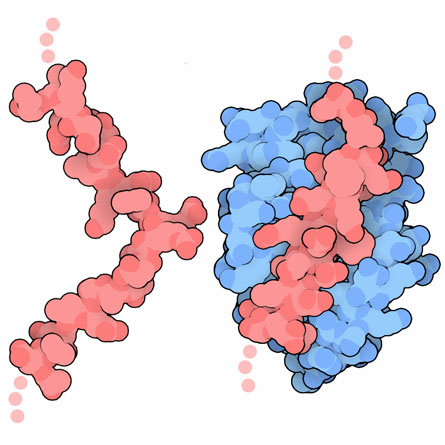The enigmatic realm of disordered protein structures beckons us to relinquish our preconceptions about conventional protein architecture. It is a fascinating juxtaposition to the well-ordered, rigid conformations that have historically dominated our understanding of biology. In this discourse, we shall embark on an exploration of disordered proteins, shedding light on their significance, mechanisms, and implications on cellular function and disease.
While globular proteins epitomize stability and a defined three-dimensional structure, a subset of proteins, designated as intrinsically disordered proteins (IDPs), defies this notion. These proteins exist in a state of dynamic equilibrium, often lacking a definitive structure under physiological conditions, yet they perform vital roles in cellular processes. Intrinsic disorder is prevalent in many segments of eukaryotic proteins, suggesting a vital evolutionary strategy that diversifies functionality while maintaining adaptability.
A pivotal question arises: what drives the evolution and functionality of these seemingly chaotic molecular entities? The answer may be traced through several functional paradigms that IDPs inhabit, including signaling, regulation, and protein–protein interactions.
The Fluid Nature of IDPs
Disordered proteins possess a remarkable fluidity, enabling them to interact with multiple partners and engage in various cellular activities. This adaptability is largely attributed to their lack of a fixed conformation, granting them the flexibility to adopt multiple shapes depending on the surrounding environment. This attribute is particularly advantageous in signaling pathways where proteins need to respond rapidly to external stimuli.
Interestingly, the historical perspective on protein folding poses a challenge to this understanding. Traditionally, proteins were viewed as entities that required a stable structure to function properly. However, research has illuminated the fact that IDPs can achieve a functional state without a fixed conformation. Their capacity to undergo conformational changes allows them to act as molecular chameleons. These dynamic traits foster multivalent interactions, enabling them to participate in signaling cascades or serve as scaffolds in larger protein complexes.
One striking example is the prion protein, which can undergo conformational changes that result in neurodegenerative diseases. Understanding the mechanisms underlying these transitions is crucial for developing therapeutic interventions.
The Dangers of Disorder
While IDPs present considerable advantages in terms of versatility, their unstructured nature is not without risk. Disordered regions are often implicated in the pathology of various diseases, including neurodegenerative disorders and cancers. The propensity for misfolding or aggregation highlights a delicate balance between functionality and instability.
Take, for instance, tau protein and its role in Alzheimer’s disease. Hyperphosphorylation of tau leads to aberrant aggregation, forming neurofibrillary tangles that disrupt neuronal function. This phenomenon illustrates how disordered regions, while being crucial for normal cellular operations, can also serve as breeding grounds for pathological conditions when mismanaged.
In cancer biology, IDPs are frequently hijacked by oncogenic pathways, contributing to the malignancy and metastasis of tumors. Their proclivity for interacting with various signaling molecules can fuel cancer progression, revealing the dark side of inherent flexibility.
The Role of Disorder in Cellular Communication
As scientific inquiry into disordered proteins continues to evolve, the importance of their roles in cellular communication becomes increasingly evident. The concept of protein ‘moonlighting’ emerges as a fascinating phenomenon where IDPs take on multiple roles, facilitating cross-talk between distinct pathways or cellular compartments.
One prominent arena for IDPs is gene regulation. Transcription factors often contain disordered regions that allow them to interact with diverse regulatory elements, amplifying the cellular response to external cues. This adaptability is akin to a conductor orchestrating an elaborate symphony, where the precise timing and interaction of each player are paramount to the overall harmony.
Moreover, the chaotic dance of IDPs within signaling networks exemplifies their significance in maintaining cellular homeostasis. Their presence in hubs of interaction fosters resilience in cellular pathways, fostering an ability to withstand perturbations while simultaneously promoting the rapid assembly and disassembly of multiprotein complexes.
Investigating IDPs: A Call for Innovative Methodologies
The study of disordered protein structures poses unique challenges, necessitating the development of innovative methodologies for characterization. Traditional techniques such as X-ray crystallography fall short when it comes to capturing the elusive nature of IDPs. Instead, methodologies like nuclear magnetic resonance (NMR) spectroscopy and small-angle X-ray scattering (SAXS) have emerged as powerful tools for elucidating conformational landscapes.
Ultimately, interdisciplinary approaches incorporating biophysics, bioinformatics, and structural biology will yield deeper insights into the functional relevance of disordered regions. As we delve deeper into the realm of IDPs, a paradigm shift in our understanding of cellular mechanisms unfolds. The interplay between disorder and functionality challenges the long-held dogma of structural rigidity, revealing a more nuanced perspective of biological processes.
The Future of Disordered Proteins in Research and Medicine
The burgeoning field of disordered proteins harbors immense potential for therapeutic applications. Targeted interventions aimed at stabilizing or destabilizing specific interactions mediated by IDPs could yield novel strategies for drug development. The challenge lies in discerning beneficial states from pathological ones—a delicate balance, indeed.
Moreover, the implication of disordered proteins extends beyond singular health conditions. Recognizing the universality of disorder in biology, the exploration of IDPs could unveil novel biomarkers for a myriad of diseases. As the nexus of structural biology continues to unravel, the interplay of order and disorder paves the way for a burgeoning understanding of life’s complexities.
As we conclude this exploration of disordered protein structures, it becomes clear that embracing unpredictability may be the key to unlocking profound truths about cellular systems. The fluidity of IDPs embodies an inherent dynamism that invites further inquiry and reassessment of established paradigms.
The challenge now rests with us: how do we embrace this playful challenge that disordered proteins offer, plumbing the depths of their chaotic elegance, and transforming our understanding of molecular biology? Engaging with the unpredictable may very well reveal the intimate connections that ground the biological tapestry—a prospect that beckons researchers, practitioners, and enthusiasts to delve deeper into this fascinating domain. The journey is just beginning, and the implications are boundless in the vast ocean of undiscovered knowledge that lies ahead.
